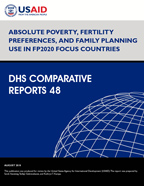
Abstract:
Broad gains in contraceptive access and use have been made in low-income countries over the past decade while poverty has declined, but the trends have been uneven. In light of the Family Planning 2020 (FP2020) goals to improve modern contraceptive uptake, and the Sustainable Development Goals’ emphasis on equitable progress, there is renewed interest in monitoring fertility preferences and family planning outcomes by poverty level. However, studies of this topic are typically constrained by the fact that standard poverty measurements are relative within surveys and cannot be compared across countries or over time. This study develops and uses a measure of absolute poverty in 31 of the 69 FP2020 focus countries, employing both an unsatisfied basic needs approach and an asset index to help differentiate among the levels of the extremely poor. The measure of absolute poverty enables us to compare and test outcomes among comparable poverty groups both within and across countries.
The study classifies married women into one of four absolute poverty groups based on their housing characteristics, household level of education, and assets. We compare results from the most recent Demographic and Health Survey in each of the 31 selected countries with results from an earlier survey in each country, conducted on average 10 years earlier. The study found a statistically significant—and in many cases substantial—decline in absolute poverty among married women in all 31 countries. There was wide variation in all key indicators across countries. On average, the ideal number of children declined most substantially among the poorest group of women, both in absolute terms and relatively across the decade. In the majority of countries there were statistically significant increases in modern contraceptive prevalence, demand satisfied for modern methods, and use of long-term versus short-term modern methods. Increases in all three indicators were greatest and most statistically significant among the poorest women. On average, inequalities between the non-poor and the poorest women declined, but substantial disparities by absolute poverty group remain both within and across countries. To address these disparities, we recommend further analysis incorporating background characteristics and programmatic case studies from countries that have largely achieved a high level of demand satisfied for modern methods while also increasing equity among poverty groups.
 Absolute Poverty, Fertility Preferences, and Family Planning Use in FP2020 Focus Countries (PDF, 1159K)
Absolute Poverty, Fertility Preferences, and Family Planning Use in FP2020 Focus Countries (PDF, 1159K)
